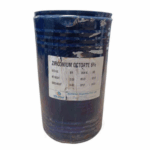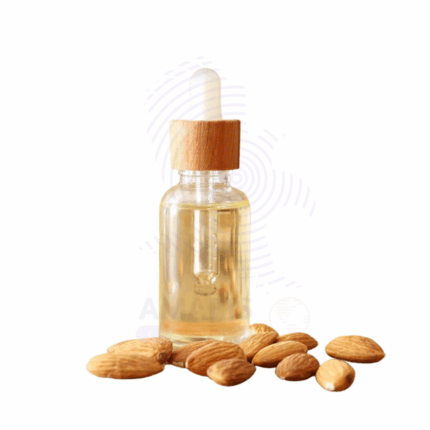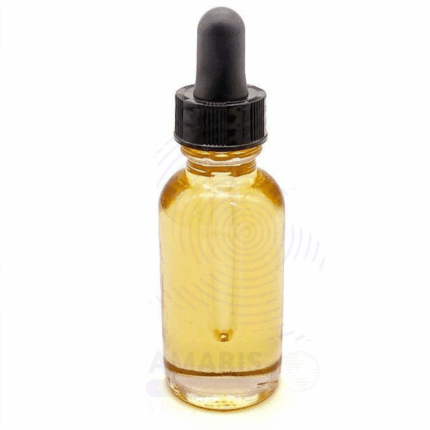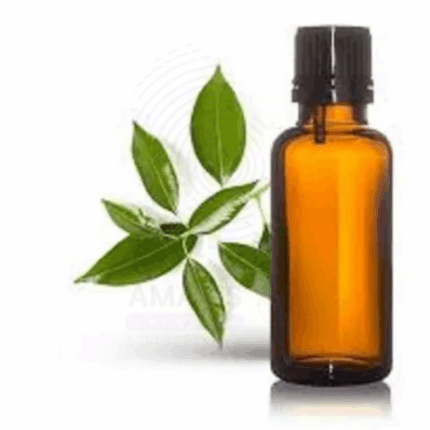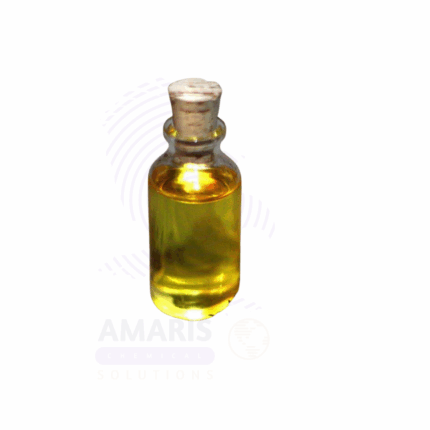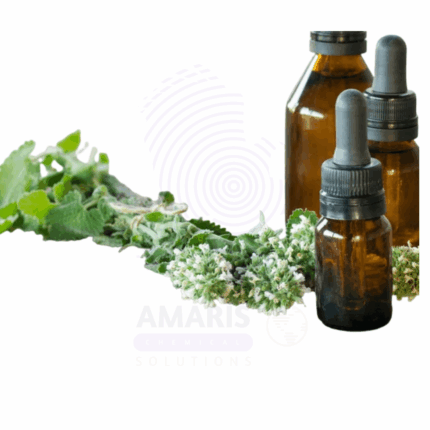Mastic Oil
Mastic Oil is a precious essential oil derived from the resin of the Pistacia lentiscus tree, predominantly found on the Greek island of Chios. Extracted through steam distillation, this oil possesses a distinctive, fresh, slightly piney and balsamic aroma with subtle woody and spicy undertones. Rich in bioactive compounds such as alpha-pinene, beta-pinene, and myrcene, Mastic Oil is valued for its powerful antimicrobial, anti-inflammatory, and antioxidant properties. Traditionally used in Mediterranean folk medicine for digestive health, oral care, and skin healing, it has gained popularity in modern aromatherapy and personal care for its soothing and cleansing effects. Mastic Oil is commonly incorporated in oral hygiene products, skincare formulations, and wellness blends, making it a versatile and revered natural ingredient.
Mastic Oil
Primary Uses
- Aromatherapy & Wellness
- Diffused to promote respiratory comfort and mental clarity with its refreshing and grounding aroma.
- Used in massage blends to relieve muscular tension and support skin healing.
- Incorporated into wellness oils for stress relief and emotional balance.
- Included in oral care aromatherapy to promote fresh breath and oral hygiene.
- Blended in personal inhalers or chest rubs to ease nasal congestion.
- Cosmetics and Personal Care
- Added to toothpaste, mouthwashes, and oral sprays for antimicrobial and freshening effects.
- Used in facial serums and creams to soothe irritated or acne-prone skin and reduce redness.
- Incorporated in lip balms and cuticle oils for conditioning and protection.
- Blended into natural deodorants for antibacterial and refreshing properties.
- Included in soaps, body washes, and shampoos for cleansing and purifying benefits.
- Added to aftershave lotions and beard oils for a clean, herbaceous scent and skin calming effect.
- Topical Applications
- Diluted and applied to minor cuts, wounds, and insect bites to support healing and prevent infection.
- Used in compresses or salves to reduce inflammation and skin irritation.
- Included in natural acne treatments and blemish spot care products.
- Applied as a soothing agent in after-sun and skin-repair formulations.
- Used in blends for scalp treatments to combat dandruff and scalp irritation.
Secondary Uses
- Cleaning and Detergent Products
- Incorporated in natural household cleaners and surface sprays for antimicrobial action and fresh aroma.
- Added to air fresheners and diffusers to neutralize odors and impart a clean, woody scent.
- Used in laundry detergents and fabric refreshers for fragrance and deodorizing properties.
- Spa and Therapeutic Products
- Included in sauna oils and steam bath blends for respiratory support and skin rejuvenation.
- Used in bath salts, body scrubs, and aromatherapy blends for relaxation and skin detoxification.
- Added to massage oils and therapeutic ointments for muscle relief and skin conditioning.
- Fragrance and Ambient Scenting
- Used as a middle or base note in natural perfumes with woody, balsamic, and herbal accords.
- Blended into scented candles and room sprays to create a calming, Mediterranean-inspired ambiance.
- Included in linen sprays and wardrobe fresheners to impart a subtle, refreshing scent.
- Pet and Animal Care
- Occasionally used in pet grooming products for odor control and skin soothing (with veterinary guidance).
- Incorporated in pet-safe cleaning sprays for natural antimicrobial properties.
- Industrial and Specialty Applications
- Employed in specialty cosmetic lines as a natural fragrance and therapeutic ingredient.
- Used in oral care products and natural remedies targeting gum health and mouth infections.
1. Basic Identification Attributes
- Botanical Name: Pistacia lentiscus
- Common/Trade Name: Mastic Oil
- INCI Name: Pistacia Lentiscus Oil
- CAS Number: 8015-14-7
- HS Code: 3301.29
- Synonyms: Lentisk Oil, Chios Mastic Oil, Gum Mastic Oil
2. Physical & Chemical Properties
- Physical State: Liquid essential oil
- Color & Odor: Pale yellow to amber; fresh, piney, balsamic, slightly spicy aroma
- Solubility: Insoluble in water; soluble in alcohol and oils
- Refractive Index: 1.460 – 1.480
- Specific Gravity: 0.860 – 0.900
- Main Components: Alpha-pinene, beta-pinene, myrcene, limonene, terpenes
3. Safety & Hazard Attributes
- GHS Classification: May cause skin irritation and sensitization in sensitive individuals
- Toxicity: Low toxicity; external use only
- Exposure Limits: Refer to Safety Data Sheet (SDS)
- Allergen Information: Contains naturally occurring allergens including pinene and limonene
4. Storage & Handling Attributes
- Storage Conditions: Store in a cool, dry, dark place away from heat and direct sunlight
- Container Type: Amber glass or aluminum containers with airtight seals
- Shelf Life: 18 to 24 months when properly stored
- Handling Precautions: Use gloves and protective eyewear during bulk handling; avoid eye and mucous membrane contact
5. Regulatory & Compliance Attributes
- Compliant with IFRA standards for fragrance use
- Produced in GMP-certified facilities
- Not classified as hazardous for transport under normal shipping regulations
6. Environmental & Health Impact
- Biodegradability: Biodegradable under environmental conditions
- Ecotoxicity: Low aquatic toxicity at typical concentrations
- Bioaccumulation: Not expected to bioaccumulate significantly
Safety Handling Precautions
- PPE Required: Gloves, goggles, and mask recommended for industrial or laboratory handling
- Handling Guidelines: Use in well-ventilated areas; avoid prolonged skin exposure
First Aid Measures
- Inhalation: Move to fresh air; seek medical attention if symptoms persist
- Skin Contact: Wash with soap and water; discontinue use if irritation occurs
- Eye Contact: Rinse thoroughly with water for 15 minutes; seek medical care if needed
- Ingestion: Do not induce vomiting; rinse mouth and seek medical help immediately
Firefighting Measures
- Fire Hazards: Flammable; keep away from ignition sources
- Extinguishing Media: Foam, dry chemical powder, carbon dioxide, water mist
- Special Precautions: Use protective clothing and breathing apparatus
- Hazardous Combustion Products: Carbon monoxide, carbon dioxide, hydrocarbons


 Preservatives(food)
Preservatives(food) Flavor Enhancers
Flavor Enhancers Acidulants
Acidulants Sweeteners
Sweeteners Antioxidants
Antioxidants Colorants(food)
Colorants(food) Nutraceutical Ingredients (food)
Nutraceutical Ingredients (food) Nutrient Supplements
Nutrient Supplements Emulsifiers
Emulsifiers
 Collectors
Collectors Dust Suppressants
Dust Suppressants Explosives and Blasting Agents
Explosives and Blasting Agents Flocculants and Coagulants
Flocculants and Coagulants Frothers
Frothers Leaching Agents
Leaching Agents pH Modifiers
pH Modifiers Precious Metal Extraction Agents
Precious Metal Extraction Agents
 Antioxidants(plastic)
Antioxidants(plastic) Colorants (Pigments, Dyes)
Colorants (Pigments, Dyes) Fillers and Reinforcements
Fillers and Reinforcements Flame Retardants
Flame Retardants Monomers
Monomers Plasticizers
Plasticizers Polymerization Initiators
Polymerization Initiators Stabilizers (UV, Heat)
Stabilizers (UV, Heat)
 Antifoaming Agents
Antifoaming Agents Chelating Agents
Chelating Agents Coagulants and Flocculants
Coagulants and Flocculants Corrosion Inhibitors
Corrosion Inhibitors Disinfectants and Biocides
Disinfectants and Biocides Oxidizing Agents
Oxidizing Agents pH Adjusters
pH Adjusters Scale Inhibitors( water)
Scale Inhibitors( water)
 Antioxidants(cosmetic)
Antioxidants(cosmetic) Emollients
Emollients Fragrances and Essential Oils
Fragrances and Essential Oils Humectants
Humectants Preservatives
Preservatives Surfactants(cosmetic)
Surfactants(cosmetic) Thickeners
Thickeners UV Filters
UV Filters
 Fertilizers
Fertilizers Soil Conditioners
Soil Conditioners Plant Growth Regulators
Plant Growth Regulators Animal Feed Additives
Animal Feed Additives Biostimulants
Biostimulants Pesticides (Herbicides, Insecticides, Fungicides)
Pesticides (Herbicides, Insecticides, Fungicides)
 Active Pharmaceutical Ingredients (APIs)
Active Pharmaceutical Ingredients (APIs) Excipients
Excipients Solvents(pharmaceutical)
Solvents(pharmaceutical) Antibiotics
Antibiotics Antiseptics and Disinfectants
Antiseptics and Disinfectants Vaccine Adjuvants
Vaccine Adjuvants Nutraceutical Ingredients (pharmaceutical)
Nutraceutical Ingredients (pharmaceutical) Analgesics & Antipyretics
Analgesics & Antipyretics
 Analytical Reagents
Analytical Reagents Solvents(lab)
Solvents(lab) Chromatography Chemicals
Chromatography Chemicals Spectroscopy Reagents
Spectroscopy Reagents microbiology-and-cell-culture-reagents
microbiology-and-cell-culture-reagents Molecular Biology Reagents
Molecular Biology Reagents Biochemical Reagents
Biochemical Reagents Inorganic and Organic Standards
Inorganic and Organic Standards Laboratory Safety Chemicals
Laboratory Safety Chemicals Specialty Laboratory Chemicals(Special Laboratory Equipment)
Specialty Laboratory Chemicals(Special Laboratory Equipment)
 Demulsifiers
Demulsifiers Hydraulic Fracturing Fluids
Hydraulic Fracturing Fluids Scale Inhibitors(oil)
Scale Inhibitors(oil) Surfactants(oil)
Surfactants(oil) Drilling Fluids
Drilling Fluids
 Dyes and Pigments
Dyes and Pigments Bleaching Agents
Bleaching Agents Softening Agents
Softening Agents Finishing Agents
Finishing Agents Antistatic Agents
Antistatic Agents
 Admixtures
Admixtures Waterproofing Agents
Waterproofing Agents Sealants and Adhesives
Sealants and Adhesives Curing Compounds
Curing Compounds Concrete Repair Chemicals
Concrete Repair Chemicals Anti-Corrosion Coatings
Anti-Corrosion Coatings
 Surfactants(cleaning)
Surfactants(cleaning) Builders
Builders Enzymes
Enzymes Solvents (Cleaning)
Solvents (Cleaning) Fragrances
Fragrances
 Electronic Chemicals
Electronic Chemicals Catalysts
Catalysts Lubricants
Lubricants Photographic Chemicals
Photographic Chemicals Refrigerants
Refrigerants Automotive chemicals
Automotive chemicals Pyrotechnic Chemicals
Pyrotechnic Chemicals
 Biodegradable Surfactants
Biodegradable Surfactants Bio-based Solvents
Bio-based Solvents Renewable Polymers
Renewable Polymers Carbon Capture Chemicals
Carbon Capture Chemicals Wastewater Treatment Chemicals
Wastewater Treatment Chemicals
 Pigments
Pigments Solvents(paint)
Solvents(paint) Specialty Coatings
Specialty Coatings Binders/Resins
Binders/Resins Additives
Additives Driers
Driers Anti-Corrosion Agents
Anti-Corrosion Agents Functional Coatings
Functional Coatings Application-Specific Coatings
Application-Specific Coatings
 Fresh Herbs
Fresh Herbs Ground Spices
Ground Spices Whole Spices
Whole Spices Spice Blends
Spice Blends Dried Herbs
Dried Herbs
 Leavening Agents
Leavening Agents Dough Conditioners
Dough Conditioners Flour Treatments
Flour Treatments Fat Replacers
Fat Replacers Decoratives
Decoratives Preservatives(baking)
Preservatives(baking)
 Plasticizers & Softeners
Plasticizers & Softeners Reinforcing Agents
Reinforcing Agents Adhesion Promoters
Adhesion Promoters Vulcanizing Agents
Vulcanizing Agents Antidegradants
Antidegradants Blowing Agents
Blowing Agents Fillers & Extenders
Fillers & Extenders Accelerators & Retarders
Accelerators & Retarders

